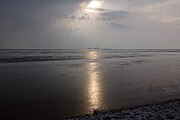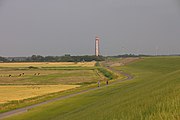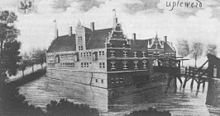Upleward
|
Upleward
Krummhörn municipality
|
|
|---|---|
| Coordinates: 53 ° 25 ′ 19 ″ N , 7 ° 2 ′ 50 ″ E | |
| Height : | 5.0 m above sea level NN |
| Area : | 5.77 km² |
| Residents : | 395 (December 31, 2012) |
| Population density : | 68 inhabitants / km² |
| Incorporation : | July 1, 1972 |
| Postal code : | 26736 |
| Area code : | 04923 |
|
Card of the Krummhörn
|
|
Upleward ( Low German Plewert ) is a small town on the west coast of East Frisia , ten kilometers northwest of Emden , on the North Sea .
geography
Upleward belongs to the municipality of Krummhörn in Lower Saxony . The coastal areas are secured here by dikes that have been increased in recent years through extensive construction work.
The core of the warf village Upleward, which has existed since at least the middle of the 7th century, consists predominantly of small, rustic single-family houses and large farms, which are grouped around the Gothic church from around 1300.
history
Upleward Castle, built in the Middle Ages, was a moated castle in the northeast of the village. It was first mentioned in 1409 and probably went back to the local noble family of chiefs . Demolition followed in 1782.
In 1744 Upleward fell to Prussia, as did all of East Frisia . In 1756 the Prussian officials compiled a statistical trade survey for East Friesland. In that year there were 13 merchants and craftsmen in Upleward, which means that the place lagged behind other places in the Krummhörn in terms of number. Among them were three linen weavers, two shoemakers and each a cooper, baker, tailor, blacksmith, carpenter and barber. The two merchants traded in trifles of salt, tobacco and soap.
For centuries, the natural depths and drainage channels that crisscross the Krummhörn in a dense network were the most important modes of transport. Not only the villages but also many farms were connected to the city of Emden and the port of Greetsiel via ditches and canals. The boat traffic with Emden was particularly important. Village boatmen took over the supply of goods from the city and delivered agricultural products in the opposite direction: “From the Sielhafenort, smaller ships, so-called Loog ships, transported the cargo to the inland and supplied the marsh villages (loog = village). The loog ships from the Krummhörn enlivened the canals of the city of Emden until the 20th century. "
Peat, which was mostly extracted in the East Frisian Fehnen , played an important role as heating material for the inhabitants of the Krummhörn for centuries . The peat ships brought the material on the East Frisian canal network to the Krummhörn villages, including to Upleward. On their way back into the Fehnsiedlungen the Torfschiffer often took clay soil from the march and the manure of cattle with which they their home were dug fertilized land.
The name of the farm, pea binding, indicates the importance of growing peas.
In April 1919 there were so-called "bacon removals" from Emden workers, which were followed by rioting on the farm workers. Together with the Rheiderland , the district of Emden was the part of East Frisia most affected by this unrest. Workers broke into the surrounding villages in closed trains and stole food from farmers in clashes. The situation only calmed down after the deployment of the Reichswehr troops stationed in the region . As a reaction to this, resident groups were formed in almost all villages in the Emden area . The Uplewards Rescue Service comprised 64 people. These had 20 weapons. The resident services were only dissolved after a corresponding decree by the Prussian Interior Minister Carl Severing on April 10, 1920.
On July 1, 1972, Upleward was incorporated into the new municipality of Krummhörn.
History of the Uplewarder Schmiede - a monument since 2000
Before 1960, each of the ten farms in Upleward had twelve or more horses for cultivating the fields and transporting agricultural products. The hooves had to be constantly trimmed, horseshoes readjusted or repaired. This included skill in handling the animals, knowledge of the loads on the horse's hooves and the diseases on the hooves. Horseshoes are necessary to gently exploit the strength of the animals in the field and on the road. The detailed drawings that Remmer's brother, Philipp Göken, left us testify to the knowledge of the blacksmith. Philipp was the blacksmith in Groothusen.
Remmer was considered a good master, with a pronounced sense of justice and openness to the people around him. His life and actions were shaped by his Christian faith. He not only took part in the church services in Upleward, but also in those of the Old Reformed Church in Campen, which followed the Bible even more strictly in its rules.
Repair of agricultural implements
As in most of the Krummhörn villages, the Upleward blacksmith was the most important craftsman in the village. Upleward had about 400 inhabitants and 10 farms on the warf and in the vicinity of the village. For agriculture, repairs of plows, harrows, rollers, carts, carriages were necessary. Often flight shares had to be sharpened, which were first hit with a hammer and then finely ground with a whetstone.
Assistance in building houses
The blacksmith's job also included helping with the construction of the houses, such as making and repairing door hinges, locks and wall anchors. The tools for this have been preserved in the Upleward forge from this period.
The ironwork:
The iron was primarily deformed and not pressed, or drilled and cut, as is done with machines today. A forge is required for processing, which could heat the iron to almost 1,000 degrees Celsius. The blacksmith placed the hot iron on the anvil and worked it with a heavy hammer until it had the desired shape. In alternation between blacksmith and journeyman, the red-hot iron was worked until it cooled down again and had to be reheated. Numerous tools were used to obtain the desired shapes.
The forge as a home for ten or more people
The varied and extensive work in dealing with iron and steel of all kinds required the help of journeymen and the training of apprentices. One remembers 'de dicke Jakob' (Builthuis), Harms and Poppinga, who lived in the smallest of the houses. With the journeymen, the house at the turn of the century became too small. The master carpenter and building contractor Johann Abrahams Herlyn (1878–1943) built a new house in 1935 without changing the old forge. Johann is Remmer's brother-in-law. Originally stables for pigs, sheep and chickens were added to the house, but in 1954 they were combined and reduced as a new building attached to the eastern part of the house (built by Folkeus Herlyn, 1914–1977). The pork smell in particular was annoying in the house earlier. With the outside stable you got rid of the smell, as Theda Göken, brother of the blacksmith Johann, said. There were 5–6 sheep that were herded along with other sheep in the village on the dike or in the field. In the evening the sheep found their way to their stable, as Mr. Hamer, the son-in-law, still experienced as a child. The garden area was used for growing vegetables and fruit. In mid-2000, potatoes and vegetables were still growing on a large part of the 633 m² area, planted by the Göken family.
His wife, Trientje Gerhardine Herlyn was born on March 8, 1877 as the daughter of the master carpenter Johann Jakobs Herlyn and his wife Tetje, née. Wübbena, in Upleward. After leaving school, she was in various households, including a. Worked for a long time in Groothusen in the pastor's household Smidt. Afterwards she worked for a year in the business and household of the merchant Reemtsma, Hamswehrum, before she got married. She was able to use the knowledge acquired here in her later business budget from 1908 onwards.
She had to take care of the journeymen and apprentices employed in the enlarged company, with full board and lodging. As Aunt Göken, she was the focal point on the way to school for the children of the Herlyn and Voss families from the Hammrichen grass house and pea bindery. During the First World War 1914–1918, when her husband was a soldier, she had to look after and raise the four children (Geertje, Theda, Engel and Johann) and also keep the business going. After the war, they took in refugees in the small house with whom the family shared rooms. Trientje was considered a lovely woman with always an open house. In 1954 the house was substantially renovated and in 1957 Foelkeus Herlyn added the stable. She died at the old age of 83 on December 13, 1960, her husband died on April 6, 1950. Thereafter, son Johann took over the forge, as far as his health permitted.
The children as keepers of the farriers
A special merit goes to the four children who have kept the smithy in its original form for over half a century. Each of the children contributed to it according to their possibilities. The daughters are particularly known for their effect as post offices or in commercial professions in the Krummhörn. These are: Geertje Engeline Göken (1909–2000), Theda Johanna Göken (1910–2000) and Engel Garreltdine Göken (1911–1999). Johann Jakobs Herlyn Göken (1913–1968) continued the forge until his death. It has remained unchanged since then. Unfortunately, there are no descendants of the Göken family .
Harvesting machines were used in agriculture, and with them tractors replaced horses. The number of horses per farm fell from an average of twelve to two over the course of 10 to 20 years between 1950 and 1970. Ready-made materials were bought for house construction, so that the high age of the blacksmithing was over. Johann had to adjust and after the death of his father (1950) ran a bicycle repair shop and dealership. In doing so, he mastered the changes and ensured a good income for the family who remained in the house. He died in Upleward in 1968 without leaving any descendants. His sister Engeline's children were also not interested in continuing the forge. Due to industrialization there were no more horses to shod, the main income in the past.
In 1994, under the management of Insa Uphoff, Groothusen, seven partners bought the smithy to protect it from changes and put it under a preservation order. At the same time, the ANNO, Society for the Preservation of East Frisian Cultural and Architectural Monuments eV was founded, which secures similar old buildings today. The forge was sold with appropriate editions (2008). Even the residential building from the 1930s (1935) is listed as a historical monument and may no longer be structurally altered. The forge can be visited every year on the Day of the Monument Protection.
Culture and sights
Buildings
In the center of the village is the Uplewarder Church , built in the 14th century .
Green spaces and recreation
Blacksmithing fences and memorial to the fallen
A special feature that is controversial on site are the forge fences designed by the Canadian artist Giuseppe Lund, which adorn the entrance to the memorial to the fallen on an artificial island, but can also be found in many other places in the area.
Dry beach
The dry beach is an artificially created beach on the remote side of the dike, right next to the campsite. The size corresponds to a soccer field and is structured by vegetation. At the campsite, mudflat hikes start, which are offered in the vicinity.
Sports
The village of Upleward has its own sports club, the Spvgg. "Nordstern" Upleward, which was founded in 1945. The club offers sports such as football, gymnastics, table tennis and dodgeball. The highlight of the football division was in 1996 the promotion to the district class . The first men is currently playing in the Aurich season 1. Upleward offers a large kite and windsurfing area. The spot has a large standing area and works with north, south and west wind.
Economy and Infrastructure
Companies
Of the five Gulf farms still preserved on the Warf , the oldest is in parts more than 300 years old. But only one is used for agriculture. There is also a hotel with a small restaurant. A newer settlement follows. Agriculture characterizes the wide march, but is no longer economically predominant. Grain is grown and beef cattle, horses and sheep are kept. Tourism is gaining in importance. Most people work in the auto industry.
traffic
Landstrasse 2 runs through the village.
There are paved footpaths along the dike, which are ideal for bike tours and inline skating. Otto's lighthouse ( Pilsum ) can be reached by bike in around 35 minutes north, while the Campener lighthouse is only around 5 minutes south.
Personalities
- Johannes Bogerman (1576–1637) - Dutch theologian
- Meenhard Herlyn (* 1944) - cancer researcher and director of the Wistar Institute in Philadelphia, USA, born on the Uplewarder grass house
- David Folkerts-Landau (* 1949) - German economist, university lecturer and non-fiction author
Web links
Individual evidence
- ^ East Frisian landscape: Upleward 2003 excavation results , accessed on February 14, 2013
- ^ Karl Heinrich Kaufhold ; Uwe Wallbaum (Ed.): Historical statistics of the Prussian province of East Friesland (sources on the history of East Friesland, Volume 16), Verlag Ostfriesische Landschaft, Aurich 1998, ISBN 3-932206-08-8 , p. 387.
- ^ Harm Wiemann / Johannes Engelmann: Old streets and ways in East Frisia . Self-published, Pewsum 1974, p. 169 (East Frisia in the protection of the dyke; 8)
- ^ Gunther Hummerich: The peat shipping of the Fehntjer in Emden and the Krummhörn in the 19th and 20th centuries. In: Emder Yearbook for Historical Regional Studies in Ostfriesland , Volume 88/89 (2008/2009), pp. 142–173, here p. 163.
- ↑ Hans Bernhard Eden: The Resident Services of Ostfriesland from 1919 to 1921. In: Emder Yearbook for Historical Country Studies of Ostfriesland , Vol. 65 (1985), pp. 81-134, here pp. 94, 98, 105, 114.
- ^ Federal Statistical Office (ed.): Historical municipality directory for the Federal Republic of Germany. Name, border and key number changes in municipalities, counties and administrative districts from May 27, 1970 to December 31, 1982 . W. Kohlhammer, Stuttgart / Mainz 1983, ISBN 3-17-003263-1 , p. 263 f .
- ↑ Iron fences at www.oz-online.de
- ↑ Meenhard Herlyn, DVM, D.Sc. | Wistar. In: www.wistar.org. Retrieved September 29, 2016 .














